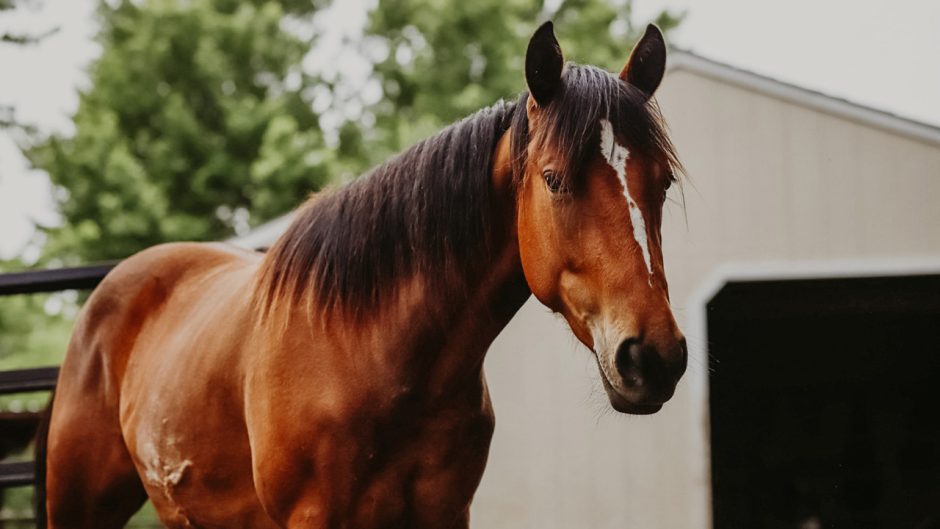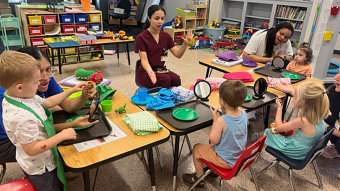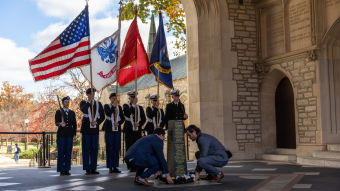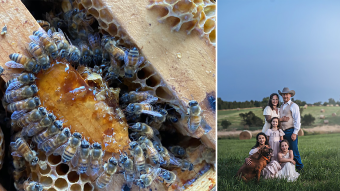
June 23, 2025
Photo courtesy Alivia Jones
When Alivia Jones first laid eyes on Cardi, a spirited young quarter horse, Jones never imagined their story would turn into one of survival. Just weeks after bringing Cardi home, Jones noticed something wasn’t right during routine wound care.
“Cardi was stiff and couldn’t really walk, she had a prolapsed eyelid, and her face just didn’t look right,” Jones said. “I was almost 100% sure it was tetanus. I had given her the first dose of the vaccine, but she wasn’t yet due for the second, so she wasn’t fully protected.”
Desperate for help, Jones traveled nearly three hours from her home in Butler, Missouri, to the University of Missouri’s Veterinary Health Center (VHC). There, a team of equine experts moved quickly to confirm the disease and begin life-saving treatment — giving Cardi a fighting chance.
A bold move, a life saved
Lynn Martin, DVM, MPH, DACVIM, an assistant teaching professor of equine internal medicine, immediately recognized the severity of Cardi’s case.
“She had the classic neurologic signs of Tetanus,” Martin said. “She moved with a rigid, uneasy gait, had a sardonic grin and a protruding third eyelid. Most horses who present like that don’t survive.”
The VHC’s equine team began using standard supportive care including wound management, intramuscular antitoxin injections, antimicrobials, tranquilizers and supportive measures like housing her in a quiet, dark stall. But Martin saw it wasn’t going to be enough.
Complicating matters, the antitoxin was in short supply nationwide. The team secured multiple doses and began treatment quickly — but by then, the toxin had already reached Cardi’s central nervous system.
Because intramuscular administration of Tetanus antitoxin is not very effective in severe cases, Martin proposed a more aggressive approach: intrathecal injection — putting the antitoxin directly into Cardi’s spinal canal.
As the first dose was delivered, Cardi collapsed.
“For a second, I thought we lost her,” Martin said. “But we gave her fluids and kept monitoring everything. And then … she got back up.”
To keep Cardi moving in the right direction, Martin proposed a novel approach to improve response to treatment: placement of an indwelling intrathecal catheter to deliver the antitoxin more slowly, safely and in smaller, repeated doses. The equine team collaborated with John Dodam, DVM, MS, PhD, DACVAA, a professor and chair of the Department of Veterinary Medicine and Surgery, to perform the delicate procedure.
The innovative intrathecal catheter — placed directly in Cardi’s spine — was key to her lifesaving treatment.
Administering the antitoxin in smaller, controlled doses helped avoid the severe reaction seen with the initial large injection, allowing treatment to continue without complications.
From there, Cardi only improved. Over six treatments, her stiffness eased. The tension left her face. She started walking, eating and even trotting again.
“It was incredible,” Martin said. “In all my years, I’ve never seen a horse come back from Tetanus like this. Cardi beat the odds because everyone — faculty, interns, students, residents and the anesthesia team — came together for a total team effort.”
Eventually, Cardi was able to return home, where Jones continued her recovery.
“Cardi is so fast now and runs everywhere she goes,” Jones said. “It’s like she knows she’s lucky to be alive.”
Cardi’s case wasn’t just a win — it was a medical breakthrough.
“As far as I know, this is the first time this procedure has ever been done,” Martin said. “It’s rare to encounter something entirely new in practice, and moments like this remind me why I became a veterinarian.”
Read more from the College of Veterinary Medicine


